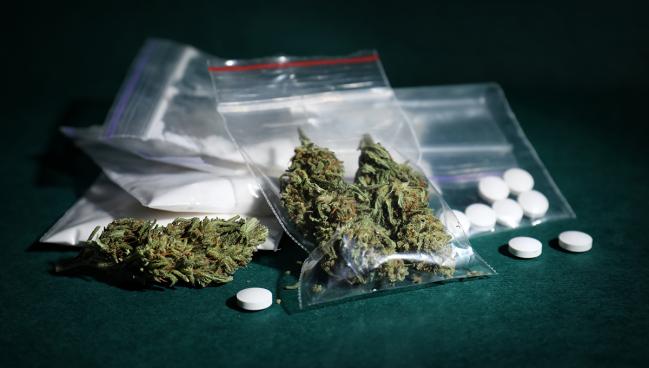From Cannabis to Opioids, Meth, and Cocaine: Drugs Are Linked to More AF
(UPDATED) A longitudinal analysis of nearly 24 million California patients shows a relationship between current use and future risk.

(UPDATED) People who use cannabis, methamphetamines, opioids, or cocaine are at increased risk of developing atrial fibrillation (AF) in the ensuing years, according to a longitudinal analysis of data from California.
This association might offer a window of opportunity, researchers suggest in the European Heart Journal.
“We’re starting to recognize that atrial fibrillation, which is the most common arrhythmia, may be a preventable disease, at least in some cases—and that lifestyle factors in particular might be a tool that can be manipulated to reduce the risk of the initial development of disease and perhaps to reduce the recurrence or the burden of the disease among people who have a diagnosis,” said Gregory M. Marcus, MD (University of California, San Francisco), the study’s senior author. Prior research on alcohol and its role as an AF trigger “has revealed this possibility that there may be other fairly common exposures that are important to the disease.”
Another factor that motivated the current analysis “is the growing leniency in allowing drug use,” he added. “The most stark example, of course, is the legalization of recreational cannabis,” a substance whose long-term effects on cardiovascular health, Marcus noted, have not yet been rigorously studied.
Some evidence has suggested methamphetamines and cocaine can lead to heart failure and ventricular arrhythmias. Data were conflicting when it came to a link between cannabis use and AF, whereas the potential impact of opioids on later AF risk was unknown.
“So we did approach this with an open mind and allowing for the possibility of a null effect, even potentially a protective effect on atrial fibrillation,” Marcus said, noting that his prior work on caffeine held some surprises.
What they found speaks more to the risks for drug users than it does to the overall burden of AF, as these cases would make up just a small slice of the whole—as the paper notes, 6 to 12 million people in the US are expected to have AF by 2050.
For clinicians, the study “suggests it’s very reasonable to probe and to not make assumptions about your patients, if simply asking a question [about drug use] and giving them information might be a way to prevent the disease or mitigate [its] adverse effects,” he said. While the difficulties posed by addiction can’t be discounted, “sometimes just showing these sorts of relationships is enough to give people a reason to quit,” said Marcus.
Ying Gue, MBChB, PhD (Liverpool Heart & Chest Hospital, University of Liverpool, England), who commented on the findings for TCTMD, said the data are “quite persuasive.” He highlighted the researchers’ use of negative controls as a means exclude inherent bias within the database.
“However, as the authors pointed out, being a retrospective database analysis, the presence of unknown confounders will still make confident causal inference inappropriate,” he noted in an email.
Gue said it’s interesting to see such a diverse group of substances all having an association with incident AF. “These drugs all have different effects on the human body, varying from stimulants like methamphetamine and cocaine to depressants like opiates and cannabis therefore biologically making it less likely to have a shared mechanism,” he noted, adding, “Perhaps social determinants of health, something not addressed within the paper, could have an important role in this.”
Overall, he said, the study serves to highlight “the gaps in our knowledge about AF, which has multiple varying risk factors that we uncover as we trawl deeper and deeper into currently available data.”
On Par With Alcohol, Tobacco Risks
For their longitudinal analysis, Marcus, lead author Anthony L. Lin, MD (University of California, San Francisco), and colleagues used California’s Office of Statewide Health Planning and Development databases to look at adults treated in the emergency department, outpatient surgery, or hospital between 2005 and 2015. Among nearly 24 million adults, incident AF occurred in 998,747 (4.2%) over the 10-year period.
Medical records contained coding that indicated 132,834 (0.5%) of the study population used cannabis, 98,271 (0.4%) used methamphetamine, 48,701 (2%) used cocaine, and 10,032 (0.4%) used opiates.
The researchers performed Cox proportional hazards regression analysis adjusted for age, sex, race, income, comorbidities, tobacco use, and alcohol abuse. All of the drugs in question were linked to increased AF incidence.
Incidence of AF by Drug Use
|
|
Adjusted HR |
95% CI |
|
Methamphetamines |
1.86 |
1.81-1.92 |
|
Opiates |
1.74 |
1.62-1.87 |
|
Cocaine |
1.61 |
1.55-1.68 |
|
Cannabis |
1.35 |
1.30-1.40 |
These risks were on par with those seen for tobacco use (HR 1.32; 95% CI 1.31-1.33) and alcohol abuse (HR 1.99; 95% CI 1.96-2.02) in the same adjusted analysis.
Additionally, patients with polysubstance use were more at risk of developing AF than those who used only one drug (HR 1.63; 95% CI 1.61-1.66). Also at higher risk were those with more-severe drug use, such as those with dependence or being treated for poisoning/adverse effects.
Analyses using two negative controls—appendicitis as well as connective/soft tissue sarcoma and renal cell carcinoma—reassuringly showed no link between these diseases and AF.
Regarding potential mechanisms for an AF increase with this diverse slate of drugs, Marcus pointed out “one thing they all have in common is that they have fairly dramatic effects on the autonomic nervous system, or essentially the influence of the nervous system on the heart.” Constant tension exists between the sympathetic and parasympathetic sides, he explained. Rapid fluctuations between the two are known to trigger AF.
It’s also important to “disentangle the constituents of the drugs versus the way in which they are consumed,” Marcus added. Inhaling particulate matter from a burned substance increases inflammation, which is another trigger for AF. And finally, cocaine can block sodium channels in the heart and thereby slow electrical conduction, increasing the likelihood of arrhythmias, he said.
He cautioned that, like any observational study, their analysis can’t prove causality. However, said Marcus, “there is certainly substantial biological plausibility to support causal relationships in every case.”
Gue suggested that future research should involve “going back to the bench and exploring how these substances could provoke atrial fibrillation.”
When treating patients with AF, clinicians should look beyond traditional risk factors like hypertension, obstructive sleep apnea, and obesity, he advised. “We should also be addressing other areas which may be overlooked and may play a role, such as use of other substances.”
Caitlin E. Cox is News Editor of TCTMD and Associate Director, Editorial Content at the Cardiovascular Research Foundation. She produces the…
Read Full BioSources
Lin AL, Nah G, Tang JJ, et al. Cannabis, cocaine, methamphetamine, and opiates increase the risk of incident atrial fibrillation. Eur Heart J. 2022;Epub ahead of print.
Disclosures
- Lin and Gue report no relevant conflicts of interest.
- Marcus reports receiving grants from the National Institutes of Health, the Patient-Centered Outcomes Research Institute, the California Tobacco-Related Disease Research Program, and Baylis Medical; consulting for Johnson & Johnson and InCarda; and holding stock in InCarda.





Comments